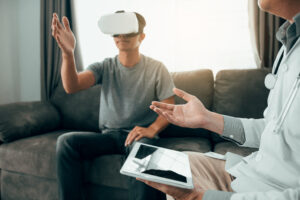
Adobe Stock/wutzkoh
Can VR Enhance Rheumatology Patient Education & Decision Making?
As most rheumatologists can attest, the autoimmune conditions we manage—as well as the treatments for them—are intellectually complex. Eloquently explaining what an inflammatory arthritis is or how a specific therapy for such a disorder works is an issue in both research studies and clinical practice.
Norwin Kandera is keenly aware of such challenges. Professionally, he has spent the past 30 years designing communication tools for international companies, many of which are in the healthcare space. He is also the father of a young woman who, at the age of 18, became one of the first five patients in the world to receive chimeric antigen receptor (CAR) T cell therapy for systemic lupus erythematosus (SLE).
In the past several years, Mr. Kandera has combined his professional expertise with his personal dedication to helping patients with SLE better understand their disease and treatment options. He has partnered with Friedrich-Alexander University Erlangen-Nürnberg, Erlangen, Germany, to create a virtual reality (VR) application, CARSLE-VR, meant to provide patient education on lupus and CAR T cell therapy.
Although the app is not currently available for use outside Germany, Mr. Kandera recently sat down with The Rheumatologist (TR) to discuss this project.

Mr. Kandera
Immersive Patient Education
TR: Can you describe the concept that initiated this VR app?
NK: We aimed to create an immersive journey through the treatment process, helping patients understand their therapy better and make informed decisions. People learn more effectively when they engage in a story or interactive experience, and VR offers a unique opportunity for this [approach].
The tour begins at the clinic entrance, where patients hear personal stories from patients. It then moves to a molecular level, explaining the mechanisms behind lupus-related inflammation. Step by step, users explore the treatment: how CAR T cells are produced, the necessity of lymphodepletion, the destruction of autoreactive B cells, the regeneration of naive B cells in the bone marrow and key aspects of aftercare.
This complex and innovative therapy requires a clear, non-trivialized explanation to aid both patients and doctors. We believe that supporting education is crucial to accelerating the adoption of new treatments and improving patient outcomes.
TR: Who is the intended audience, and how do you ensure accessibility?
NK: Primarily, we intend for the main audience to be patients who are seeking to understand what happens in their bodies as part of the disease process. This understanding is key in allowing them to make informed decisions about treatment, and they need comprehensive, yet accessible, medical information to do so.
Healthcare professionals also benefit from the app because this tool provides a quick introduction to key treatment concepts. Switching a patient’s therapy—especially to a novel, data-limited modality, such as CAR T cell therapy—is a significant decision for any doctor, one that should not be taken lightly, and it benefits from patients and physicians being on the same page with regard to potential risks and benefits.
We also see value for caregivers, family members and clinical staff, with the app helping ensure that everyone involved is well informed. Lastly, students at the high school level and beyond who are interested in these medical science concepts can use the app to familiarize themselves with emerging immunological therapies in the field of rheumatology.
TR: Are there other VR apps for patient education in rheumatology or medicine?
NK: We initially developed a single-player, VR version from our social VR [version], allowing individuals to navigate the experience independently. Currently, we are collaborating with experts from Universitätsklinikum Erlangen to extend our work beyond lupus, including myositis and systemic sclerosis, both of which are autoimmune conditions that have been successfully treated with CAR T therapy. [Because] many models, animations and interactions are already in place, adapting to new diseases is efficient and cost effective.
Another project focuses on rheumatoid arthritis, [for which] we are developing an interactive mobile game with augmented reality and mixed reality elements to illustrate inflammatory bone disorders. By way of background, augmented reality is a technology that superimposes a computer-generated image on a user’s view of the real world, thereby providing a composite view. Mixed reality is a medium that consists of immersive computer-generated environments in which elements of a physical and virtual space are combined.
We believe that such novel approaches will help expand the scope and utility of our applications.
‘Our personal experience reinforced the need for better patient education. … When facing a severe disease, understanding all treatment options is vital for making the best decisions.’ —Mr. Kandera
TR: What advantages does VR offer for patient education, compared with traditional methods?
NK: This therapy is new and complex, combining immunology and oncology. Understanding treatment mechanisms, risks and side effects—such as cytokine storm—requires a deep knowledge base that is challenging for doctors to convey within the usual time constraints of a busy day.
VR provides an accessible, immersive learning environment, guiding patients through the treatment process step by step. It allows doctors to explain complex topics more effectively and answer questions with the help of contextualization. Additionally, it ensures consistent, high-quality medical education, reducing misunderstandings and increasing patient confidence.
We strongly believe that well-informed patients tolerate and respond to therapy better than those who are less well informed.
TR: What is your personal connection to CAR T cell treatment for autoimmune diseases?
NK: I am the father of Patient No. 5. During early discussions in Erlangen, Georg Schett, MD, head of the Department of Medicine 3 (Rheumatology and Immunology) of the Friedrich-Alexander University Erlangen-Nürnberg, asked about my work. At the time, we were developing VR projects for rare diseases, such as atypical hemolytic-uremic syndrome, paroxysmal nocturnal hemoglobinuria and myasthenia gravis. Dr. Schett introduced me to Sandra Jeleazcov, head of science communication at Erlangen, and we explored VR’s potential for lupus treatment education.
Our personal experience reinforced the need for better patient education. We spent years navigating medical discussions, often resorting to Google searches to understand terms and treatment options. This [approach] was not because doctors were unhelpful—on the contrary, they were excellent—but because they lacked the time for in-depth explanations.
When facing a severe disease, understanding all treatment options is vital for making the best decisions. As parents, we tried to give our daughter hope, but without sufficient information, we struggled to explain risks, benefits and alternatives. This experience fueled my passion for developing tools that empower patients and caregivers.
TR: What are your ultimate goals for this VR app and similar products?
NK: We currently offer two VR applications: a social VR experience, in which the doctor and patient navigate the treatment together; and a single-player version, allowing independent exploration.
Our vision is to expand beyond pre-therapy education. Patients visit the hospital multiple times—why not use waiting periods for deeper education? They could learn about cytokine storm prevention, CAR T cell behavior in the body, immune system re-education and post-treatment care.
We also aim to provide this tool to caregivers and family members because they play a crucial role in patient support. Additionally, [the app] can serve as an educational resource for medical students and doctors.
Lastly, we plan to expand globally. The app is already available in German, English and Italian. Thanks to close collaboration with medical experts, we ensure scientific accuracy, making it an ideal application for further translation and wider distribution.
 Jason Liebowitz, MD, is an assistant professor of medicine in the Division of Rheumatology at Columbia University Vagelos College of Physicians and Surgeons, New York.
Jason Liebowitz, MD, is an assistant professor of medicine in the Division of Rheumatology at Columbia University Vagelos College of Physicians and Surgeons, New York.
The Technicalities
Although the app is currently available only in Germany, Mr. Kandera hopes to expand worldwide. Requirements include META Quest 2 or higher, a VR headset and a META email account.



